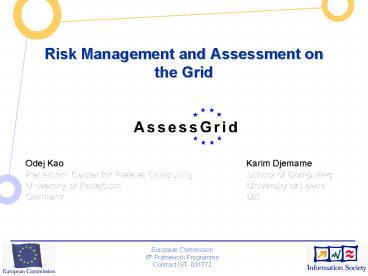Risk Management and Assessment on the Grid - PowerPoint PPT Presentation
1 / 20
Title:
Risk Management and Assessment on the Grid
Description:
Paderborn Center for Parallel Computing School of Computing ... Axiom. Mathematical symbols such as ... The Grid: What is it? sensor nets. Shared data archives ... – PowerPoint PPT presentation
Number of Views:50
Avg rating:3.0/5.0
Title: Risk Management and Assessment on the Grid
1
Risk Management and Assessment on the Grid
Odej Kao Karim Djemame Paderborn Center for
Parallel Computing School of Computing University
of Paderborn University of Leeds Germany U
K
European Commission6th Framework
Programme Contract IST- 031772
2
Outline
- The Grid Definition
- The need for Quality of Service
- Risk on the Grid
- Research Context
- User
- Broker
- Service Provider
- Grid services based on SLAs and QoS
- Proposed System
- Research Challenges
3
In this talk, there wont be any mention/use of
- Theorem
- Proof
- Lemma
- Axiom
- Mathematical symbols such as
- ? ? ? ? ? ? ? ? ? ? ? ? ? ? ? ? ? ? ? ? ? ? ? ?
4
The Grid What is it?
- The Web sharing of information
- The Grid sharing everyting
- The Grid is rapidly transforming science,
engineering, medicine and business - driven by exponential growth (1000/decade)
computers
software
Grid
sensor nets
instruments
Shared data archives
Diagram derived from Ian Fosters slide
colleagues
5
The Grid Metaphor
6
Risk? What Risk?
- Risk
- Defined as the combination of the probability of
an event and its consequences - Risk is negative
- Avoid it using risk management
- Risk is positive
- Opportunities may be created as a result of risk
taking - Potential benefits when taking certain risk
- Risk management
- Identification and treatment of risk
7
Why Risk Assessment and Risk Management in Grids?
- Grid technologies reached high level of
development - Large-scale Grid deployment needs
- Commercial Grid providers and services
- Working demonstrators in different areas
- Standardisation efforts for access and
interoperability - Early adopters underline core shortcomings
- Quality of Service ? guaranteed resource usage
over time - Security, Trust, and Dependability
- Service Level Agreements (SLAs) address
shortcomings - Definition of business relationship
- Forces development of QoS-aware middleware/OS
8
SLAs Best Effort is not Good Enough
9
SLAs Best Effort is not Good Enough
- Specified amount and quality of resources over
certain time mandatory to reach desired
performance - Delegation of particular resource capabilities
over a defined time interval from resource owner
to requester - SLA as explicit statement of expectations and
obligations in a business relationship between
service provider and customer
10
Grid Providers and SLAs
- SLAs needed, but providers are cautious about
adoption - Why? ?Business case risk
SLA violation and penalties due failures, DoS
attacks, overloading
Missing indicators ? QoS level to be offered?
Enough resources for Grid jobs?
Fault tolerance available?
Actions to be initiated?
Bottleneck indicators for system planning
Acceptable price and penalty regarding current
risk, effort?
What is the risk of accepting an SLA?
11
Grid Brokers, Users and SLAs
- Reliability as selection criterion
QoS?
Trustable QoS level information?
Reliability with respect to utilisation?
QoS information service?
Decision-support for job assignment?
Reliable provider for e.g. time-critical
application?
Penalty high enough to cover potential delays?
What is the risk of assigning an SLA?
12
Grid Services based on SLAs and QoS
End user
Broker
Reliable and trustworthy Grid provider?
Reliable services for workflow mapping?
Improve efficiency, reliability, and trust to
attract Grid users?
Provider
13
What Do We Want to Achieve?
- Risk indicators as core part of SLA assignment
and acceptance - Customised risk presentation for improved
usability and trust - Decision/planning/management-support for
QoS-aware Grids - Grid provider evaluation and competition
14
Proposed System
- Generic, customisable, and interoperable
open-source software for risk assessment, risk
management, and decision-support in Grids
Risk assessment and management
Provider/ Broker/ End-user perspective
Integration in Grid service
Integration in Grid middleware
Broker service
Monitoring
Planning-based RMS
Consultant /Confidence service
Ad-hoc risk management
Integration in Grid fabric
15
Dependencies in Grid Layers
16
Research Challenges
- Risk Assessment
- Methods and tools for monitoring, gathering, and
aggregating relevant data - Static and dynamic data utilisation
- Network-condition, overall Grid activity
- Specific business policies
- Methods for risk assessment
- Customised presentation of risk-related indicators
Risk granularity
End user
Broker
Provider
17
Research Challenges
- Risk Management
- Develop concepts for using risk
- Estimate risk
- Risk-indicators for self-organising fault
tolerance - Risk-aware negotiations and SLAs,
scheduling, outsourcing - Risk-based decision-support for capacity planning
and infrastructure management - Aggregation of risk-indicators for objective
provider ranking and competition
18
Acnowledgements
19
AssessGrid Broker View?
How to compute this? It is not a simple average,
as each SLA is connected to a certain risk of
failure
20
AssessGrid End user View?































